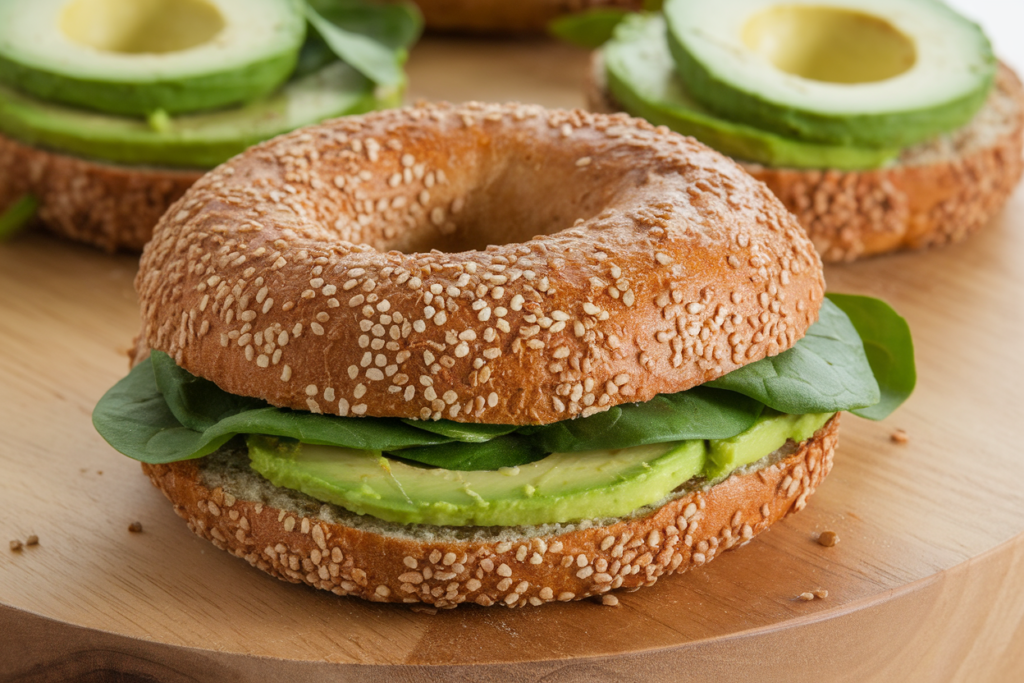Introduction
Salt bagels, a cornerstone of traditional bagel culture, hold a special place in the hearts of bagel enthusiasts. Characterized by their dense, chewy texture and a liberal topping of coarse salt, they offer a unique balance of flavors that pair beautifully with a variety of spreads and accompaniments. Whether enjoyed plain or with creative toppings, salt bagels stand out as a timeless breakfast staple.
Their robust flavor profile and satisfying crunch have made them a go-to for those who crave a savory start to their day. This article explores everything there is to know about salt bagels—from their history and preparation to their ideal pairings and nutritional considerations.
If you’re ready to dive into the world of this salty delight, stay tuned for a comprehensive exploration of salt bagels.
Table of Contents
The History of Salt Bagels
Origins of Bagels
The story of bagels traces back centuries, with roots in Jewish communities of Eastern Europe. Bagels, as we know them, first emerged in Poland around the 17th century, where they were known as obwarzanek, a ring-shaped bread boiled before baking. This unique preparation method created the dense, chewy texture that remains a hallmark of bagels today.
Immigrants brought bagels to the United States in the late 19th and early 20th centuries, establishing them as a staple in Jewish bakeries. Over time, bagels gained popularity beyond these communities, evolving into a quintessential part of American breakfast culture.
How Salt Became a Defining Topping
The addition of salt to bagels is a nod to the simplicity and versatility of the original recipe. Coarse salt, sprinkled generously over the dough before baking, enhances the flavor and provides a satisfying crunch. This innovation likely followed the introduction of other toppings such as sesame seeds and poppy seeds.
Salt bagels became especially popular in New York City, where bagel culture thrived. The bustling Jewish bakeries of the city adapted traditional recipes to meet the demands of diverse palates, leading to the creation of variations like the salt bagel. Today, salt bagels remain a favorite for their bold flavor and versatility.
The Cultural Significance of Salt Bagels
Beyond their taste, salt bagels symbolize the adaptability and creativity of immigrant food traditions. They stand as a testament to the melding of old-world recipes with modern preferences, offering a piece of history with every bite.
Salt bagels also exemplify the role of bagels as a communal food. Whether enjoyed at a bustling deli or during a family brunch, they bring people together, sparking nostalgia and comfort.
Ingredients and Nutritional Value
Common Ingredients Used in Salt Bagels
Salt bagels rely on a simple yet essential combination of ingredients that create their distinct texture and flavor. Here’s a breakdown of the key components:
- Flour: Typically, high-protein bread flour is used to achieve the dense and chewy structure characteristic of bagels.
- Water: Essential for binding the ingredients and activating the yeast.
- Yeast: Gives the dough its rise and contributes to the slightly tangy flavor.
- Salt: Integrated into the dough and added generously as a topping to provide a savory flavor burst.
- Sweetener: Often malt syrup or sugar is used in the dough and sometimes in the boiling water to give bagels a hint of sweetness.
- Toppings: Coarse or kosher salt is the signature topping, applied just before baking.
Some variations may include additional ingredients such as eggs, butter, or milk, but traditional salt bagels stick to a straightforward formula.
Nutritional Benefits and Concerns
Salt bagels can be both nourishing and indulgent. Here’s what to expect in terms of nutrition:
- Calories: A standard-sized salt bagel typically contains between 250-350 calories, depending on its size and recipe.
- Protein: The high-gluten flour used provides a good source of protein, making bagels a filling breakfast choice.
- Carbohydrates: Bagels are carb-heavy, offering sustained energy when paired with protein-rich spreads.
- Sodium: As the name suggests, salt bagels are high in sodium, with an average of 500-800 mg per serving, depending on the amount of salt topping.
While they’re a great option for active individuals needing an energy boost, those monitoring their sodium intake may need to limit their consumption or consider a lower-salt version.
Comparing Salt Bagels to Other Bagel Types
Salt bagels stand out among other bagel varieties due to their bold, salty topping. Here’s a quick comparison:
- Plain Bagels: A versatile base, but often considered less flavorful than their seasoned counterparts.
- Everything Bagels: More complex in flavor, combining salt with other toppings like sesame, onion, and poppy seeds.
- Cinnamon Raisin Bagels: The sweet counterpart to savory salt bagels, ideal for those with a preference for sugary flavors.
Salt bagels are perfect for those who enjoy intense, savory flavors and a crunchy texture, offering a satisfying alternative to sweeter or milder bagel types.
How to Make the Perfect Salt Bagel

Essential Tools and Ingredients
Making salt bagels at home requires a few basic tools and high-quality ingredients. Here’s a checklist to get you started:
- Tools:
- A large mixing bowl
- Stand mixer with a dough hook (optional)
- Kitchen scale for accurate measurements
- Large pot for boiling
- Slotted spoon for removing bagels from the boiling water
- Baking sheet and parchment paper
- Wire rack for cooling
- Ingredients:
- Bread flour (high-gluten recommended)
- Active dry yeast
- Warm water
- Sugar or malt syrup
- Kosher or coarse sea salt (for topping and dough)
Step-by-Step Preparation Guide
Follow these steps to craft perfectly chewy salt bagels at home:
- Prepare the Dough:
- Combine warm water and yeast in a mixing bowl, allowing the yeast to activate (about 5-10 minutes).
- Add flour, a pinch of salt, and sugar or malt syrup to the yeast mixture. Knead by hand or with a stand mixer until the dough is smooth and elastic, about 8-10 minutes.
- Cover the dough with a damp cloth and let it rise in a warm place for 1-2 hours, or until it doubles in size.
- Shape the Bagels:
- Divide the dough into equal portions (about 8 for standard-sized bagels).
- Roll each piece into a ball, then poke a hole through the center with your thumb and stretch it to form the signature bagel shape.
- Boil the Bagels:
- Preheat your oven to 425°F (220°C).
- Bring a large pot of water to a boil and add a tablespoon of sugar or malt syrup.
- Boil the bagels for 1-2 minutes on each side. This step creates the chewy crust bagels are known for.
- Add the Salt Topping:
- Place the boiled bagels on a parchment-lined baking sheet.
- Sprinkle coarse salt generously over each bagel while they’re still wet from boiling.
- Bake:
- Bake in the preheated oven for 20-25 minutes, or until golden brown.
- Let them cool on a wire rack before serving.
Common Mistakes to Avoid
- Skipping the Boiling Step: This is essential for achieving a chewy crust. Don’t skip it!
- Overloading with Salt: While salt is the star, too much can overpower the flavor. Sprinkle with care.
- Underproofing the Dough: Insufficient rising time can result in dense, tough bagels. Be patient and allow the dough to double in size.
Making salt bagels is a rewarding experience that fills your home with the aroma of fresh bread and delivers a delicious, homemade treat.
Salt Bagel Pairings and Toppings
Classic Spreads and Pairings
Salt bagels offer a bold, savory base that pairs beautifully with both simple and indulgent spreads. Here are some timeless favorites:
- Cream Cheese: The creamy richness balances the saltiness of the bagel perfectly. Variations like chive or smoked salmon cream cheese add an extra layer of flavor.
- Butter: A classic choice for those who prefer a minimalistic approach. Melted butter on a warm salt bagel is simply irresistible.
- Lox: Thinly sliced cured salmon is a luxurious pairing that complements the bagel’s salty notes.
- Egg and Cheese: Transform your salt bagel into a hearty breakfast sandwich with scrambled eggs and melted cheese.
- Hummus: For a plant-based option, hummus adds a creamy texture and subtle earthiness to your bagel.
Creative Ways to Enjoy a Salt Bagel
For adventurous eaters, salt bagels can be the canvas for innovative toppings and combinations. Here are some unique ideas:
- Avocado Smash with a Twist: Top your salt bagel with mashed avocado, a drizzle of olive oil, and a sprinkle of chili flakes for a modern brunch treat.
- Caprese Bagel: Layer fresh mozzarella, tomato slices, and basil leaves, then drizzle with balsamic glaze for a fresh, Italian-inspired twist.
- Spicy Tuna Salad: Mix canned tuna with sriracha mayo and pile it onto your bagel for a protein-packed lunch.
- Pizza Bagel: Spread marinara sauce, sprinkle shredded mozzarella, and add your favorite toppings. Toast until the cheese melts.
- Bagel BLT: Build a classic bacon, lettuce, and tomato sandwich using your salt bagel as the base.
Drinks to Complement Salt Bagels
Pairing your salt bagel with the right beverage elevates the overall experience. Some popular choices include:
- Coffee: A hot cup of coffee complements the robust flavors of the bagel.
- Iced Tea: The refreshing nature of iced tea balances the saltiness, especially during warm weather.
- Orange Juice: A tangy, sweet contrast to the savory bagel.
- Sparkling Water: A neutral option that refreshes the palate without overshadowing the bagel’s flavor.
Tips for Serving
- Toasting: Toasting a salt bagel enhances its crunch and brings out its flavors. Avoid over-toasting, which can make it overly dry.
- Temperature: Serve warm for maximum enjoyment. Reheat leftovers in the oven rather than a microwave to maintain their texture.
- Storage: Keep salt bagels fresh by storing them in an airtight container or freezing them for longer shelf life.
Salt bagels are versatile enough to be enjoyed at any time of day, and the right toppings can transform them from a quick snack into a gourmet meal.
Health Considerations

Sodium Intake and Salt Bagels
Salt bagels, as the name suggests, are naturally high in sodium due to their coarse salt topping. While they are a flavorful treat, understanding their impact on your diet is essential:
- Sodium Content: A single salt bagel can contain between 500 to 800 mg of sodium, which accounts for a significant portion of the recommended daily sodium intake (2,300 mg for most adults).
- Potential Risks: Excessive sodium intake can contribute to high blood pressure, increased risk of heart disease, and water retention, making it important to enjoy salt bagels in moderation.
- Balanced Consumption: Pairing a salt bagel with low-sodium toppings, like fresh vegetables or unsalted spreads, helps offset the saltiness while maintaining flavor.
Tips for Healthier Versions
For those who love salt bagels but want a healthier option, small tweaks can make a big difference:
- Reduce Salt Topping: Opt for a lighter sprinkling of salt or mix it with sesame or poppy seeds to dilute the sodium content.
- Choose Whole Grain Options: Whole grain flour increases fiber content, aiding digestion and making the bagel more filling.
- Bake at Home: Homemade bagels allow you to control the amount of salt and experiment with alternative flours and toppings.
- Portion Control: Enjoy half a bagel with nutrient-rich toppings like avocado or lean protein to create a balanced meal.
Nutritional Balance with Pairings
To make your salt bagel a more balanced meal, consider these healthy pairing strategies:
- Protein: Spread low-fat cream cheese, hummus, or Greek yogurt to add protein and cut back on unhealthy fats.
- Vegetables: Include cucumber slices, tomatoes, or spinach for added vitamins and minerals.
- Healthy Fats: Avocado or a drizzle of olive oil enhances flavor while providing heart-healthy fats.
Are Salt Bagels Suitable for Everyone?
While salt bagels are a delicious option for many, they may not be the best choice for:
- Individuals with High Blood Pressure: The high sodium content can exacerbate this condition.
- Low-Sodium Diets: For those following strict sodium guidelines, alternatives like plain or whole wheat bagels are better choices.
- Children and Older Adults: Both groups are more susceptible to the effects of high sodium and may benefit from reduced-salt options.
By being mindful of portion sizes and pairings, salt bagels can fit into a balanced diet while still offering their signature savory taste.
FAQs About Salt Bagels
Can You Freeze Salt Bagels?
Yes, salt bagels freeze exceptionally well, making them a great option for meal prepping or keeping extras on hand. Here’s how to do it:
- Cool Completely: Let the bagels cool to room temperature after baking or purchasing.
- Wrap Individually: Use plastic wrap or foil to wrap each bagel individually, ensuring an airtight seal.
- Store in a Freezer Bag: Place the wrapped bagels in a large freezer bag and remove excess air before sealing.
To reheat, thaw the bagel at room temperature or in the microwave, then toast for the best texture and flavor.
What’s the Best Way to Reheat a Salt Bagel?
The best way to reheat a salt bagel is by toasting it. This method restores the crispness of the crust while warming the inside. Avoid microwaving without toasting, as this can make the bagel chewy or rubbery.
Are Salt Bagels Vegan?
Most traditional salt bagels are vegan, as the dough typically contains no animal products. However, it’s always good to check the ingredient list, especially if the bagel contains sweeteners like honey or toppings that might include dairy or eggs.
How Long Do Salt Bagels Stay Fresh?
Salt bagels are best enjoyed fresh on the day they’re baked. However, they can be stored:
- At Room Temperature: In a paper bag or loosely wrapped for up to 2 days.
- Refrigerated: In an airtight container for up to 4 days, though refrigeration can make them slightly dry.
- Frozen: Up to 3 months with proper storage.
Why Do Salt Bagels Sometimes Taste Bitter?
The bitter taste can occur if the salt used as a topping is overly concentrated or unevenly distributed. Using high-quality coarse salt and a light hand during preparation can help avoid this issue.
Can You Customize a Salt Bagel?
Absolutely! Salt bagels are highly versatile. You can customize them with mixed toppings like sesame seeds, sunflower seeds, or even grated cheese for a unique twist. Experimenting with different spreads and fillings further personalizes your bagel experience.
When exploring the timeless appeal of salt bagels, it’s essential to consider their perfect pairing companions, such as cream cheese. The combination of a chewy, salted crust with a creamy spread has been widely celebrated, as detailed in Bagel with Cream Cheese: The Perfect Combination. For those interested in other ways to enjoy bagels, you might wonder, “Can I Take Bagel with Cream Cheese?” This article delves into the portability and convenience of this classic treat, adding to the versatility that makes salt bagels a beloved choice among breakfast options. For readers looking to enhance their bagel-making or serving ideas, these resources offer a wealth of complementary insights.
Conclusion
Salt bagels, with their signature salty crunch and chewy texture, remain a beloved breakfast staple for good reason. Their rich history, versatile flavor, and cultural significance have made them a cherished part of the bagel world. Whether you’re enjoying one at a New York deli, baking them at home, or pairing them with your favorite toppings, the salt bagel offers endless possibilities.
From its traditional roots to modern variations, the salt bagel proves that sometimes, simplicity truly is the ultimate sophistication. So, the next time you crave a savory treat, reach for a salt bagel and savor its timeless appeal.

